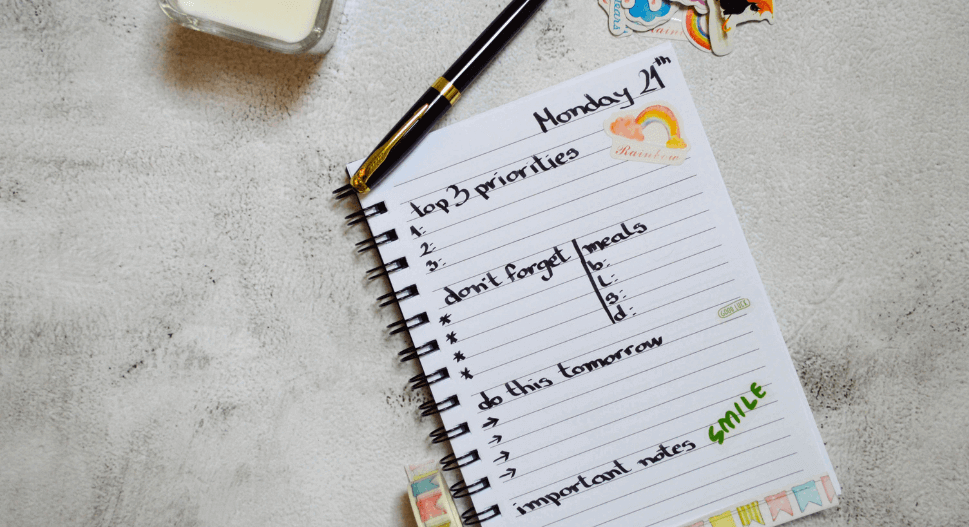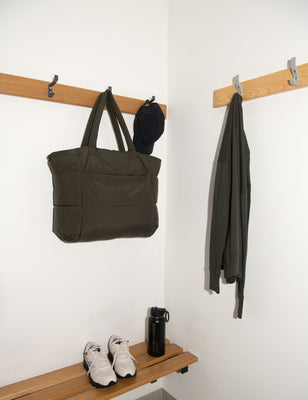Ever find yourself lost amongst forgotten reminders and unfinished tasks? You’re not the only one. However, there’s a way to get your day-to-day affairs in order, thanks to the all-new bullet journal.

Okay, bullet journals have been around for a while. But this self improvement method is coming back into the mainstream, and we’re loving it. Don’t worry if you weren’t blessed with natural organisational skills. A simple bullet journal notebook is here to help you find your way.
Bullet journals are notebooks and diaries designed to help you stay on top of modern life. You can add any features to suit your needs, from goal trackers to calendars. For some, bullet journals are emotional, and for others, they’re streamlined systems. Each is different, and that’s the beauty of the concept!
Are you looking for a new hobby? In need of a lifesaving tool? We’re here to help. Keep reading to find bullet journal ideas for beginners today.

How To Start A Bullet Journal
When you’re ready to start your habit tracker bullet journal, ensure you have a new notebook and some craft supplies.
You don’t have to be a full-on artist to create a journal, but many owners enjoy taking some time to decorate their notebooks. Popular designs include watercolour backgrounds, fine-liner text, and highlighted sections. Interested in getting creative? Search for bullet journal ideas on Instagram or Pinterest for visual inspiration.
Follow the steps below to start your bullet journal journey.
Index
The first step towards a complete bullet journal notebook is an index. The index is the front section of your notebook, and you use this as a table of contents. Keep this page neat. In time it’ll be the key to understanding your notebook!
Journalers usually add page numbers and a symbol key to update as they go. The symbols you include are entirely up to you - so don’t hold yourself back! Scroll down to learn more about these visual elements.
Future log
Fail to prepare, and you’re preparing to fail! Your future log section is all about planning for far-off events.
Forget your daily tasks. Here you’ll enter any upcoming events. Think about birthdays, project deadlines, and any other appointments. You’ll never receive a last-minute “Where are you?” text again.
The future log should be inspirational. Think of this section as a ‘time machine’, and use it to inspire your daily work when times get stressful. Some bullet journal owners add images in this section to add to the inspirational vibe. Whether you add pictures of your vacation spot or healthy food inspo, adding some aesthetic design is advised.

Monthly log
One of the most popular bullet journal sections, your monthly log, sets you up for the next month. Many users add a calendar, a list of projects to tackle, and any significant events coming in the month.
Monthly logs also tend to include fitness, finance, and food trackers to help you stay on top of your health and wellness. What will you be aiming for this month? Scribble it down now!
Daily log
Finally, your daily log is what you’ll spend most time filling out. As you’d expect, you enter your daily to-do list, reminders, and short-term plans here. Daily logs look very different for each user, but they tend to include a vague plan for each day. Ideal if you’re ready to get organised and stop winging it!
Some bullet journal owners prefer weekly logs, but this depends on your preference and how busy your schedule is.
Your daily log should receive rapid entries. Try to enter new tasks and appointments as they occur to keep track of your to-dos. This might seem challenging initially, but when you embrace the task, it can become a mindful moment to set up your day.

Symbols
Finally, it’s time to create your own language via ‘symbols’ or ‘signifiers’. These refer to visual symbols that represent how urgent tasks are, whether they’re complete, and so on.
Popular symbols include:
- Priority tasks with an exclamation point (!).
- Different shapes for different task statuses.
- Filled-in shapes for completed content.
Of course, you can use simple methods, like highlighting, to show tasks are complete. But many love the personalised and visual aspect of symbols.

Top 3 Reasons You Should Use A Bullet Journal
Getting creative with your bullet journal is a popular trend, but there’s much more to this mission than making an attractive notebook.
Here are the three top benefits of building a habit tracker bullet journal.
Increased productivity
Perhaps the most popular benefit of a bullet journal, these notebooks offer increased productivity. If you’re interacting with your to-do list and setting clear goals, you’ll have more motivation to work towards them. This translates into increased productivity and a more focused mind. We can’t complain about that!
Daily habit tracking
When you work with a bullet journal, you have to interact with your goals and tasks daily. In busy modern life, pushing tasks out of mind is easy. These journals hold users accountable via daily tracking and frequent check-ins. Ideal for anyone trying to make consistent self improvement changes with new habits.
One streamlined system
There are many notebook apps, systems, and planners online right now. But, many of these apps are separated into different categories. For example, food apps, fitness apps, and goal-setting apps. With so many different planners and apps, it’s easy to lose track of your progress. This is where the BuJo comes in.
The bullet journal takes all aspects of your life and places them in one streamlined place. No more forgetting anything. All you need in one location - your organisational skills will be on point!

The Takeaway
Bullet journals are here to stay, and we’re not mad about it!
If you’re getting started with your own notebook, remember one thing - BuJos don’t need to be perfect! Striving for perfection can put some users off. Instead, take time to enjoy the process and be mindful. You never know; you might find a new talent for crafts!
Will you be experimenting with bullet journal ideas? Or do you still need to figure out this organised planner method? Let us know in the comments!





























































